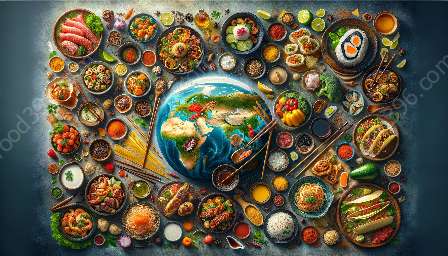World cuisines offer a fascinating array of flavors and ingredients, influenced by diverse cultures. This comparative study takes you on a journey to explore the unique characteristics of various global cuisines, from traditional dishes to modern culinary trends.
Understanding Global Cuisine
Global cuisine is a reflection of traditions, geography, and cultures from different parts of the world. Each region has its own distinct food culture with diverse flavors, ingredients, and cooking techniques. When comparing world cuisines, it's essential to consider not only the taste and appearance of dishes, but also the historical and cultural significance behind them.
Asian Cuisines
Asian cuisines are known for their vibrant flavors, aromatic spices, and unique cooking methods. The cuisines of countries such as China, Japan, India, and Thailand differ greatly, yet they share common elements such as the use of rice, noodles, and a variety of seasonings. Chinese cuisine, for example, is characterized by its use of contrasting flavors, while Japanese cuisine is known for its emphasis on fresh and seasonal ingredients. Indian cuisine showcases a rich blend of spices and herbs, resulting in diverse and flavorful dishes. Thai cuisine, on the other hand, is celebrated for its harmonious balance of sweet, sour, salty, and spicy flavors.
European Cuisines
European cuisines vary widely across the continent, with each country boasting its own culinary traditions and specialties. French cuisine, often considered the epitome of gourmet dining, is known for its exquisite sauces, delicate pastries, and rich cheeses. Italian cuisine, with its emphasis on fresh, simple ingredients, has brought us beloved dishes like pasta, pizza, and risotto. Spanish cuisine offers a tantalizing array of tapas and paella, showcasing the country's diverse regional flavors. In Eastern Europe, cuisines from countries like Poland, Hungary, and Russia feature hearty stews, savory pierogies, and unique desserts influenced by local ingredients.
African and Middle Eastern Cuisines
African and Middle Eastern cuisines are characterized by bold, aromatic flavors and the use of spices and herbs. The cuisines of North Africa, including Moroccan, Algerian, and Tunisian, feature tantalizing tagines, couscous dishes, and flavorful grilled meats. Middle Eastern cuisines, such as Lebanese, Turkish, and Persian, are celebrated for their use of fresh herbs, dried fruits, and aromatic spices in dishes like kebabs, hummus, and falafel.
American and Latin American Cuisines
American cuisine is renowned for its diverse influences, stemming from Native American, European, and Asian traditions. Traditional American dishes like barbecue, fried chicken, and apple pie showcase a rich tapestry of flavors. Latin American cuisines, including Mexican, Brazilian, and Peruvian, offer a tantalizing mix of indigenous ingredients, European influences, and vibrant spices. Mexican cuisine, in particular, features a wide array of chili peppers, corn-based dishes, and flavorful salsas, while Brazilian cuisine highlights a variety of grilled meats and tropical fruits.
The Influence of Cultural Diversity on Cuisines
Exploring the world's cuisines not only highlights their unique flavors and ingredients, but also emphasizes the influence of cultural diversity on food traditions. Migration, trade, and historical conquests have brought about the exchange of culinary techniques and ingredients, resulting in the fusion of flavors and the evolution of different cuisines. For example, the Silk Road facilitated the spread of spices and innovations between Asia and Europe, leading to the integration of new ingredients and culinary methods in both regions.
Migrations from Africa, Asia, and Europe to the Americas introduced new foods such as tomatoes, potatoes, and chili peppers, which became integral to the cuisines of the New World. The resulting fusion of cultural and culinary practices has given rise to dishes like Italian-American pizza, Tex-Mex cuisine, and the New York-style bagel, showcasing the dynamic nature of culinary diversity.
Modern Culinary Trends and Globalization
As the world becomes increasingly interconnected, modern culinary trends reflect a fusion of global flavors and ingredients. Chefs and food enthusiasts are constantly experimenting with cross-cultural influences to create innovative dishes that blend traditional techniques with contemporary flavors. Fusion cuisine, for example, combines elements of different culinary traditions to offer unique dining experiences. This trend has given rise to dishes like sushi burritos, Indian-inspired tacos, and Korean barbecue burgers, showcasing the creative potential of cross-cultural culinary experimentation.
Furthermore, the globalization of food supply chains has made it easier for consumers to access a wide variety of international ingredients and products, leading to the incorporation of diverse flavors into everyday cooking. Whether it's the use of exotic spices in traditional recipes or the fusion of different cooking styles, globalization has played a significant role in shaping the way we experience and appreciate world cuisines.
Conclusion
Comparative studies of world cuisines offer a rich tapestry of flavors, ingredients, and cultural influences that reflect the diverse traditions and histories of different regions. By exploring the unique characteristics of global cuisines, we gain a deeper appreciation for the interconnectedness of food and drink, and the dynamic evolution of culinary traditions. Embracing the diversity of world cuisines provides an opportunity to celebrate cultural exchange and to savor the flavors of the world on our plates.




































